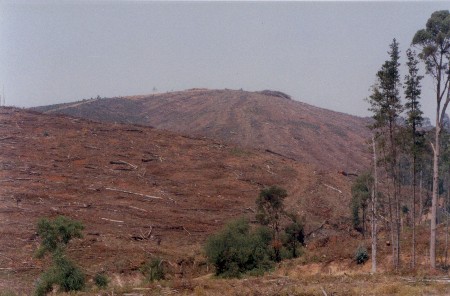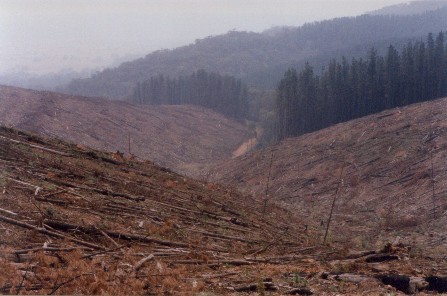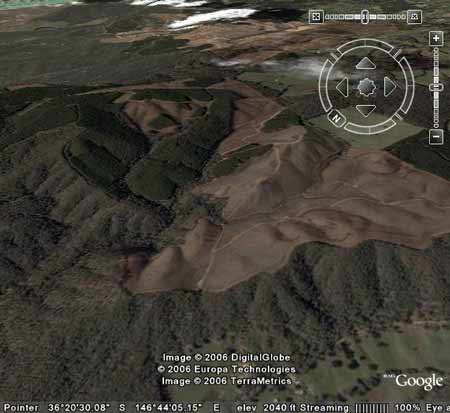Region: Ovens
|
| Herbicide | Label Rate max as kg/ha | Used to control | Notes | Application |
| Carfentrazone-Ethyl | 0.036 | |||
| Clopyralid | 2.55 | Woody Weeds | Highly Toxic/Potential Ground water Contaminant | air or ground |
| Glyphosate | 3.6 | Herbaceous and woody weeds, noxious weeds | ||
| Hexazinone | 4 | Woody Weeds | Ground Water Contaminant | Aerial, ground, spot |
| Metsulfuron-Methyl | 0.06 | Woody Weeds, Noxious Weeds | Potential Ground Water Contaminant | Aerial, ground or spot |
| Triclopyr | 3 | Woody and Noxious Weeds | Ground, spot, basal bark |
Proclaimed Water Catchment Area: A 3km strip of this plantation lies inside the north western boundary of the Nine Mile Creek, Clear Creek & Hurdle Creek Water Supply Catchment (Gazetted 13/6/79). THIS PART OF THIS CATCHMENT SUPPLIES DRINKING WATER TO YACKANDANDAH. Several northern tributaries of Nine Mile Creek lie inside the plantation boundary. The creeks in the Nine Mile Creek catchment all flow into Yackandandah Creek, a tributary of the Kiewa River, which in turn is a tributary of the Murray River.

MURRAY RIVER SUPPLIES WATER TO YARRAWONGA, RUTHERGLEN, COBRAM, BARMAH, ECHUCA , KERANG, PIANGIL, SWAN HILL, ROBINVALE, MILDURA. Most of the plantation however lies in the Magpie Creek catchment which flows into Reedy Creek in the Ovens River catchment.

THREATENED FISH NOTES - KIEWA RIVER: Murray Cod found in Kiewa River. River needs environmental flows. Yackandandah Creek has populations of Mountain Galaxias and Blackfish, however stream levels do fluctuate and the creek is very temperamental to slight changes upstream. Mountain Galaxias (Galaxias olidusi) taxonomy is under review. Outcome could determine a separate species in the North East.
THREATENED FISH NOTES - OVENS RIVER: Most important river in Victoria in regard to the survival of the Murray Cod. Murray Cod spawn almost as far up as Myrtleford and the Ovens supplies recruitment for the Murray River as well. The Ovens has no dams and is a river of extreme national significance. Trout Cod are now being found in the Ovens and may set up a self sustaining spawning population. Trout Cod have been successfully stocked into Ovens and upper Ovens, downstream of Myrtleford and going up the King River - past Moyhu. All the tribs of the Ovens are important for native fish including King, Buffalo and Buckland Rivers.Ex Gold Mine Area: It appears that gold workings occurred on the western side of this plantation in the Reedy Creek catchment. Workings occurred in Fred's Gully and Hellshole Gully.
Responsible Authority: Indigo Shire Council
Plantation Catchment: Many creeks throughout plantation feeding into Nine Mile Creek. Wombat Creek, Guy Creek, Yackandandah Creek, Stinger Creek, Marcam Creek, Back Creek/Yackandandah Creek/Kiewa River.

Catchment Managment Authority: North East Catchment Management Authority
Other Notes taken from Soil Conservation Authority’s 1978 report;
‘A REPORT ON THE CATCHMENTS OF NINE MILE CREEK, CLEAR CREEK AND HURDLE CREEK (LAKE KERFERD).
“P3 . . . Town water supply for Beechworth is drawn from Lake Kerferd. Surface run-off from part of its natural catchment by passes the storage, the majority of water coming from diversions originating in the adjacent Nine Mile Creek Catchment . . . The water supply for Yackandandah is diverted from Nine Mile Creek at a small offtake weir via a 200mm gravity main to a 1ML service basin at Walkers Saddle 2.5km downstream, then via a 150mm pipe to Yackandandah . . . p4 The water supply for Beechworth is taken from Frenchman’s Gully a tributary of Nine Mile Creek that is diverted to Lake Kerferd by aqueduct and pipe. . . Water from these catchments becomes very turbid after heavy rainstorms. This is due to various land disturbance activities occurring in the catchments . . .”
p4 “Geology. The catchments are mainly situated on consolidated sediments of Ordovician age, consisting of generally fine grained feldspathic sandstone beds up to 1m thick and greywacke interbedded with dark grey shale, mudstone and siltstone. The beds are tightly folded and faulted with slaty cleavage being developed in areas. Fresh rock is grey whereas weathered rock is yellow-brown or brown . . . The Mount Stanley granite forms a small pluton in high, forested country 6km south of the town of Stanley in the upper catchment area . . . Recent colluvial and alluvial deposits are extensive along the watercourses in the catchments. The more recent alluvium forms a relatively narrow band along the stream margins and consists of unconsolidated sand, silt, gravel and clay, with no soil development. The colluvial deposits are unconsolidated mixtures of clay and weathered fragments of Ordovician sediments washed and sluiced from upslope. Large areas of these recent deposits have been sluiced in the search for gold. . .
Geomorphology: About three quarters of the catchments lie on the undulating Stanley Plateau and one quarter on the steep escarpment of the foothills from the Victorian Alps. The upper area of the catchments is on the well dissected plateau with the land surface varying from short steep slopes to rolling fans and steeper hills. In the lower catchment, undulating to moderately sloping valley bottoms are present where colluvial alluvial fans are the major landform. These grade into moderate slopes up to low ridges or residual hills . . . The creation of the northerly draining streams that produced the catchments occurred in late Tertiary, as a result of the Kosciusko Uplift. The Stanley Plateau of 760m (average) may have been part of the Pre-Kosciusko surface.
Soils: The dominant soils over most of the southern, upper half of the catchments are deep friable and hard reddish gradational soils. The steeper slopes have stony soils and friable brownish gradational soils are common in these areas. Shallow depressions may have weakly bleached yellowish gradational soils, although friable reddish gradational soils may also occur in these locations. In the middle of the lower northern half of the catchments there is abundant evidence of colluviation of the soil mantle, and depth to bedrock varies according to whether the site is a depositional or an erosional one. Friable reddish gradational soils with reddish brown light clay B horizons are the most widespread soils on the deeper colluvial material . . .
p6 A wide band of softwood plantations straddles the centre of the catchments. . . Records kept for sixteen years at Stanley State Nursery in the upper catchment area indicate an average rainfall on the plateau of 1275mm . . .
p7 Forestry is the principal use of public land with the Stanley Plateau the most extensively developed. State owned plantations of exotic conifers take up a large proportion of the Plateau. Softwood timber plantations take up about 3000 ha of the catchment, with some stands up to 35 years old. Softwood species were first planted to stablize sluiced areas on land disturbed by gold-mining operations. These softwoods proved economically viable and the plantations expanded onto better land. . .
p7 Hazards to the Water Supply. In the southern half of the catchments, the erosion hazard is generally low. However, occasionally severe storms may cause rilling and sheet erosion on cultivated land, particularly where cultivation is carried out up and down the slopes. The soils are mostly deep and permeable and relatively erosion resistant. Areas of compacted soil, such as earthen roads, may rill or scour. In the northern half of the catchments the erosion hazard is generally moderate because of the close association of steeper slopes and valley drainage lines in which soils with dispersible subsoils occur. Loss or reduction of ground cover causes excessive runoff, therefore clearing presents a problem.
p8 The utilization of areas stripped of soil during gold mining is a problem. These are not favoured for agriculture or forestry although many have been planted with pines. Areas cleared of native and softwood timber and the roads are producing turbid runoff that is finding its way into the drainage lines. In particular roadside drainage tends to concentrate in the table drains on the unsealed roads. The infrequent disposal results in erosion of the soil and sedimentation in the streams. Since 1975 these problems have intensified. The offtake weir on Nine Mile Creek is approximately 1 km below the lowest point of the area cleared for pine establishment. Undoubtedly the close proximity of the cleared area to the streams has been a contributing factor in the high levels of turbidity being experienced in the Yackandandah water supply. The catchment has an intensive road network including four wheel drive and dry weather tracks as well as sealed main roads. It is likely that the tracks would yield turbid flows to the stream . . .”

Feb 03: Recent logging in Magpie Creek catchment. No buffers on drainage line.
Ovens River: The rivers all flow north, from heavily
forested mountain country through excessive river flats to the Murray
River. Murray cod populations close to the Murray River. Small river
blackfish are common in many rivers, Macquarie Perch are still occasionally
caught, and catches of golden perch are also being reported. Brown trout
widely distributed through system with rainbow trout most abundant in
upper reaches. Upstream from Myrtleford - Brown Trout to 1.3kg, some
rainbow trout, small redfin and river blackfish.
Ovens River: Upstream from Myrtleford - Brown Trout to 1.3kg, some rainbow
trout, small redfin and river blackfish.
Source: A Guide to the Inland Angling Waters of Victoria by BR Tunbridge,
PL Rogan, CA Barnham. Department Conservation and Environment. Arthur
Rylah Institute for Environmental Research, 123 Brown St, Heidelberg,
3084. (4th ed - 1991)
|
93-136a: Feb 01: Logging on mild slopes in plantation.
|

